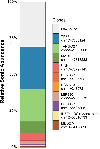CD4+ T-Cell Lymphoma Harboring a Chimeric Antigen Receptor Integration in TP53
- PMID: 39908432
- PMCID: PMC11801235
- DOI: 10.1056/NEJMoa2411507
CD4+ T-Cell Lymphoma Harboring a Chimeric Antigen Receptor Integration in TP53
Abstract
Malignant T-cell transformation after chimeric antigen receptor (CAR) T-cell therapy has been described, but the contribution of CAR integration to oncogenesis is not clear. Here we report a case of a T-cell lymphoma harboring a lentiviral integration in a known tumor suppressor, TP53, which developed in a patient with multiple myeloma after B-cell maturation antigen (BCMA) CAR T-cell therapy.
Copyright © 2025 Massachusetts Medical Society.
Figures









References
Publication types
MeSH terms
Substances
Grants and funding
LinkOut - more resources
Full Text Sources
Medical
Research Materials
Miscellaneous
